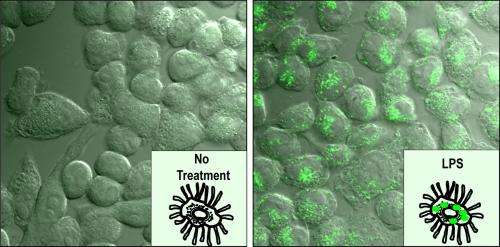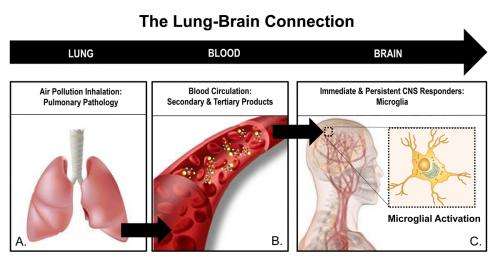Urban air pollution exposure may trigger toxic responses in brain cells and impact neurodegenerative disease pathways

(Medical Xpress)—From diesel exhaust to gaseous pollutants and suspended particulate matter, such as dust, smoke and fumes, air pollution from transportation, industry and energy generation has taken a toll on the environment and human health.
While the adverse effects of air pollution on the cardiovascular and respiratory systems have been well documented, little is known about how the associated toxins may impact the brain and the central nervous system. In recent years, experts have reported a marked rise in the prevalence of stroke, autism and cognitive decline in the elderly.
Researchers such as Michelle Block, Ph.D., associate professor in the Department of Anatomy and Neurobiology in the Virginia Commonwealth University School of Medicine, are now on a mission to define the impact of air pollution on the brain and central nervous system.
Through basic science, Block and her team are working to understand the underlying molecular mechanisms in hopes of developing an intervention that can protect human health.
Recent scientific reports suggest air pollution exposure and the activation of a specific group of cells found in the brain being studied in Block's laboratory may play a role in the increased incidence of central nervous system diseases and neurological conditions. They have observed that these factors may also impact the neurodegenerative disease process.
Last week, Block, presented her team's significant research findings to peers from across the country during a symposium she co-organized at the 2014 annual meeting of the American Association for the Advancement of Science, held in Chicago, from Feb. 13 to 17.
"Angry" cells, toxic responses
Block's research examines microglia, a group of resident immune cells found in the brain and spinal cord, which can display a kind of dual personality – one good, and the other bad if agitated.
Under normal conditions, microglia primarily serve as the defenders of the central nervous system. They bring balance to the system. They destroy infectious agents, engulf various unwanted cellular and foreign materials and promote regrowth of damaged neural tissue.

But microglia can be dangerous when they are exceptionally "angry" and are known to leave behind significant bystander damage to neighboring cells. This adverse behavior may lead to the development of any number of neurodegenerative diseases, including Parkinson's disease, Alzheimer's disease, or Gulf War Illness.
In some ways, microglia are similar to misunderstood superhero The Incredible Hulk. Despite having a decent-sized heart and extraordinary abilities to help save the day, nobody wants to stir his rage and anger.
Block's laboratory specializes in understanding the cellular and molecular machinery responsible for essentially fueling microglia "anger" – why they become chronically and excessively activated to drive damage in the brain.
"Our goal is to define how microglia detect and respond to air pollution, reveal when this microglial response may actually be damaging the brain, identify potential markers of ongoing silent neuropathology and ultimately use the mechanistic information we acquire as a tool to halt the induced or augmented neuropathology," Block said.
In several peer-reviewed, published reports, Block and her colleagues have demonstrated that exposure to a diverse source of urban air pollution can trigger toxic microglial responses and impact neurodegenerative disease pathways.
"Given the prevalence of human exposure to urban air pollution above safety regulations, it is critical to understand the underlying mechanisms through which air pollution affects the brain," Block said. "We hope to find an opportunity to intervene and protect human central nervous system health."
According to Block, her team's work shows that many components of urban air pollution, including the particle components of air pollution, also called particulate matter, and gases, such as ground level ozone, activate microglia.
Some of the problems with this cell type come in when the same molecular tools used by microglia internalize (eat) and clean up toxic stimuli and accidentally trigger the switch to an excessive, angry activation state. The work she presented reveals how air pollution does this, essentially leaving microglia with much more than a mouthful. Her lab has discovered that the MAC1 pattern recognition receptor may be a common mechanism through which microglia detect and ultimately misinterpret different forms of air pollution as an invading pathogen to result in excessive production of reactive oxygen species and consequent damage to neighboring brain cells.
Further, ongoing research in Block's lab aims to define where damage to the lungs through inhaled toxicants produces injury signals in the circulation that are not only detected by microglia in the brain, but are responsible for shifting microglia to a deleterious phenotype impacting central nervous system health. She refers to this as a "Lung-Brain Axis."
















